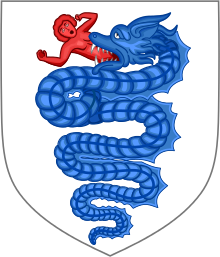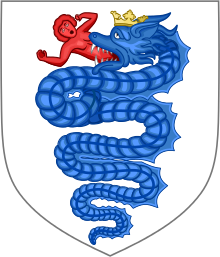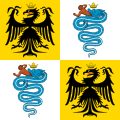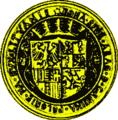
The caduceus is the staff carried by Hermes in Greek mythology and consequently by Hermes Trismegistus in Greco-Egyptian mythology. The same staff was borne by other heralds like Iris, the messenger of Hera. The short staff is entwined by two serpents, sometimes surmounted by wings. In Roman iconography, it was depicted being carried in the left hand of Mercury, the messenger of the gods.

Ludovico Maria Sforza, also known as Ludovico il Moro, and called the "arbiter of Italy" by historian Francesco Guicciardini, was an Italian nobleman who ruled as the Duke of Milan from 1494 to 1499.
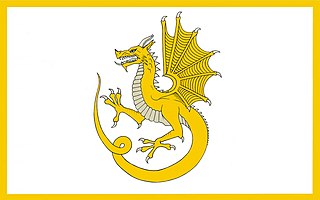
The wyvern is a type of mythical dragon with two legs, two wings, and often a pointed tail which is said to be a venomous stinger.

The Duchy of Milan was a state in Northern Italy, created in 1395 by Gian Galeazzo Visconti, then the lord of Milan, and a member of the important Visconti family, which had been ruling the city since 1277.

Galeazzo Maria Sforza was the fifth Duke of Milan from 1466 until 1476. He was notorious for being lustful, cruel, and tyrannical.

The Castello Sforzesco is a medieval fortification located in Milan, Northern Italy. It was built in the 15th century by Francesco Sforza, Duke of Milan, on the remnants of a 14th-century fortification. Later renovated and enlarged, in the 16th and 17th centuries it was one of the largest citadels in Europe. Extensively rebuilt by Luca Beltrami in 1891–1905, it now houses several of the city's museums and art collections.

Piadena is a former comune in the Province of Cremona, Italy. On January 1, 2019 it merged with Drizzona to form Piadena Drizzona.
Rescaldina is a comune (municipality) that is part of the Metropolitan City of Milan, in the Province of Milan in the Italian region Lombardy, with a population of 14,211 distributed over about 8 km2, and located about 25 kilometres (16 mi) northwest of Milan.

The flag of Milan consists of a red cross on a white field. Whilst similar to the Cross of Saint George, the flag instead symbolises the connection between Saint Ambrose and the city of Milan.

Ottone Visconti was Archbishop of Milan and Lord of Milan, the first of the Visconti line. Under his rule, the commune of Milan became a strong Ghibelline city and one of the Holy Roman Empire's seats in Italy.
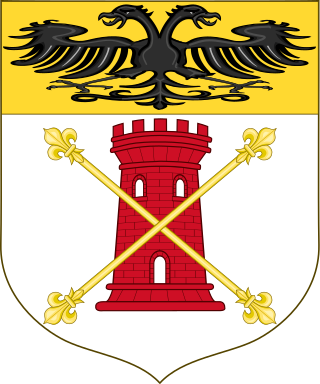
The House of Della Torre were an Italian noble family who rose to prominence in Lombardy during the 12th–14th centuries, until they held the lordship of Milan before being ousted by the Visconti.

Milan, Italy is an ancient city in northern Italy first settled under the name Medhelanon in about 590 BC by a Celtic tribe belonging to the Insubres group and belonging to the Golasecca culture. The settlement was conquered by the Romans in 222 BC and renamed it Mediolanum. Diocletian divided the Roman Empire, choosing the eastern half for himself, making Milan the seat of the western half of the empire, from which Maximian ruled, in the late 3rd and early 4th century AD. In 313 AD Emperors Constantine and Licinius issued the Edict of Milan, which officially ended the persecution of Christians. In 774 AD, Milan surrendered to Charlemagne and the Franks.
The Spanish monarchs of the House of Habsburg and Philip V used separate versions of their royal arms as sovereigns of the Kingdom of Naples-Sicily, Sardinia and the Duchy of Milan with the arms of these territories.

The Visconti Castle of Abbiategrasso is a medieval castle in Abbiategrasso, Lombardy, northern Italy. It was among the first Visconti castles built according to their typical quadrangular layout. In the 14th and 15th centuries, it was one of the preferred residences of the duchesses of Milan of the Visconti and Sforza houses. Today, the castle's surviving part serves as the seat of the municipality of Abbiategrasso.

The flag of Lombardy is one of the official symbols of the region of Lombardy, Italy. The current flag was officially adopted on 4 February 2019, although it has been used de facto since 12 June 1975.

The Visconti Castle of Jerago is a castle of Middle Age origin located in Jerago, Lombardy, Northern Italy. Having been a property of members of the Visconti house between the 13th and 18th centuries, it retains still today their memory in its name.

Leonardo is a historical drama television series created by Frank Spotnitz and Steve Thompson. The series was produced by Italian Lux Vide in collaboration with Rai Fiction, Sony Pictures Entertainment, with Frank Spotnitz's Big Light Productions and Freddie Highmore's Alfresco Pictures in association with France Télévisions and RTVE.

The Visconti Castle of Pavia is a medieval castle in Pavia, Lombardy, Northern Italy. It was built after 1360 in a few years by Galeazzo II Visconti, Lord of Milan, and used as a sovereign residence by him and his son Gian Galeazzo, first duke of Milan. Its wide dimensions induced Petrarch, who visited Pavia in the fall of 1365, to call it "an enormous palace in the citadel, a truly remarkable and costly structure". Adjacent to the castle, the Visconti created a vast walled park that reached the Certosa di Pavia, a Carthusian monastery founded in 1396 by the Visconti as well and located about 7 kilometres (4.3 mi) to the north.
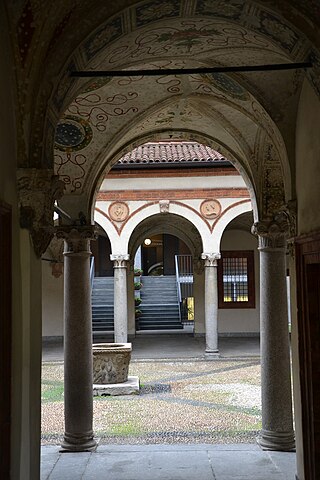
The Palazzo Dal Verme was the noble residence of one of the most powerful families of the Visconti and Sforza court in the 15th century. The courtyard remains today, one of the greatest examples of civil construction from the Renaissance era in Milan. It is located at 3 Via Giacomo Puccini.

The three symbols of Milan, the capital city of Lombardy, are the coat of arms, the gonfalon and the flag, as stated in the municipal charter.
